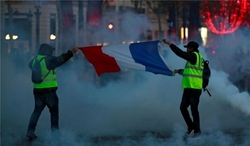 Thousands of protesters rallies across France as Yellow Vest demonstrations show no sign of abating on their 20th week despite authorities banning many locations.
Thousands of protesters rallies across France as Yellow Vest demonstrations show no sign of abating on their 20th week despite authorities banning many locations. RNA - The twentieth wave of Yellow Vest manifestations in France on Saturday has gathered 33,700 people, a report by the French Interior Ministry informed, but the rally organizers claimed that over 100,00 people were present, World News reported.
Last Saturday, nearly 40,500 people took part in the protest, out of them 5,000 protested in Paris.
In Paris where more than 4,000 went out to the streets, demonstrators gathered in two locations, forming a joint column and marched towards Trocadéro square.
Several skirmishes broke out between protesters and police present in large quantities in riot gear. A thick plume of smoke was observed occasionally but it's not immediately clear what was its source.
French police sources announced that during the unsanctioned acts of protest in Paris, 37 people have been detained. Police detained over 100 people in the whole country, with 56 demonstrators held in custody.
The upper house of the French parliament has greenlighted a bill giving police broad powers to quell unrest. It comes as a rights watchdog warned of civil liberties being undermined in France due to crackdowns on demonstration.
The Yellow Vest protests have been marred by violence from both sides. While the French authorities blame radicals for inciting violence, protesters accuse the police of disproportionate use of force that has resulted in limbs getting torn off, eyes lost and other life-changing injuries for demonstrators who were caught up in the clashes.
The French newspaper Journal du Dimanche has published a letter to President Emmanuel Macron written by the country’s 35 leading ophthalmologists, in which they asserted that the police’s use of rubber bullets has led to an “epidemic of serious eye injuries”.
Many people risk losing their vision, doctors say, hinting that the current dismal developments are no coincidence as rubber balls fly with great force and are often directed inaccurately.
French riot police have become notorious for using hand-held guns, locally known as defence-ball launchers or Flash-Balls, during the demonstrations that been ongoing since November.
The currently deployed model – named LBD 40 – fires 40mm foam projectiles, roughly the size of a golf ball. Rubber bullets have apparently become the police’s primary means of combating unruly crowds, and have been deployed more than 13,000 times, according to local officials.
Also, UN High Commissioner for Human Rights Michelle Bachelet called for a “full investigation” of France’s excessive use of force towards the Yellow Vests who, according to her words, demand a “respectful dialogue”.
The majority of severe injuries among demonstrators have came from “non-lethal” crowd control weapons such as rubber-bullets, tear gas and stun grenades. Attempts by human rights activists and community leaders to roll back the use of these arms have been unsuccessful, leading some to accuse the government of complicity in the violence.
Government figures show that over 2,000 protesters and over 1,000 police officers have been injured since protests broke out in November.
The wave of the Yellow Vest rallies — named after the obligatory attribute of French drivers — started in France in mid-November. Thousands of demonstrators wearing bright yellow vests have gathered in major French cities, including Paris, to protest President Emmanuel Macron's controversial fuel tax hikes and deteriorating economic situation.
The protests have been marked by violence and public disorder. While the French government ultimately abandoned plans to raise fuel taxes, which triggered the rallies, and introduced other measures to improve the country's socioeconomic situation, the demonstrations have continued and morphed into a wider outcry against Macron’s economic policies and high living costs.
847/940